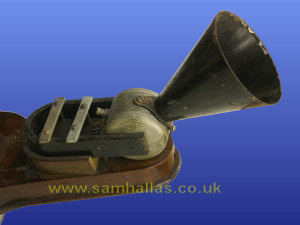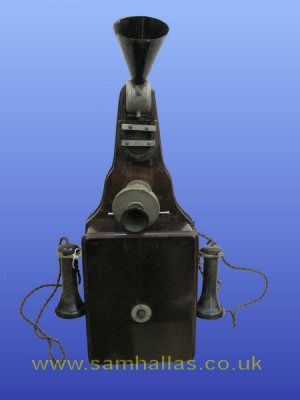

Sam Hallas' Website
The phonopore was a telephone that could be connected to the same wire as a Morse circuit allowing simultaneous speech and telegraphy. It saved telecomms administrations and the railways a great deal of money towards the end of the 19th Century by removing any urgent need to install new line plant to provide service for the new-fangled telephone. However, it did not start life in quite the same guise….

By the late nineteenth century the electric telegraph had reached almost every corner of the earth. The telegraph companies were making a lot of money from sending messages. Naturally the more messages they could send the more money they could make. As a result inventors were vying with each other to produce methods of sending more messages over a single telegraph circuit. Some methods sent the messages faster, such as Charles Wheatstone's high speed Morse system using pre-punched paper tape and inking receivers (1867). Another method used clever circuitry to send two messages on the same wire such as Edison's duplex telegraph of 1874. Other methods interleaved several messages at a time, such as Emile Baudot's printing multiplex telegraph (1874). Alexander Bell had been developing a multiple telegraph using harmonic resonances which led him onto the method of transmitting speech, the telephone, which he patented in 1876. [Picture: Wheatstone high-speed morse transmitter, formerly in BT collection]

So why C. Langdon-Davies decided to develop yet another method of duplicating a telegraph circuit we don't know. However in 1891 he published 'An Explanation of the Phonopore and more particularly of the Simplex Phonopore Telegraph' [Ref 1]. The principle seems simple enough today. By using an audible tone a second Morse circuit could be created on the same wire as the normal direct current circuit. The tone was generated by a self-interrupting relay, or buzzer. Separation between the two Morse circuits could be achieved by the use of a capacitor, but in fact Langdon-Davies used a bifilar coil with open circuit ends. The mutual capacitance between the windings provided the coupling and the inductance of the windings helped to filter the Morse clicks. Langdon-Davies described the coupling as a sound channel, or 'phonopore'.[Pictures from Langdon-Davies pamphlet 'Une explication...' Ref 1]

The simplicity of the principle means that the phonopore required little in the way of adjustment once set up. The Explanation pamphlet contains details of trials which show that the phonopore was capable of working over prodigious distances.
John Goldfinch drew my attention to a paper presented by Captain P. Cardew in 1886 to the Society of Telegraph Engineers, the forerunner to the Institution of Electrical Engineers. In it he describes tests and field trials of an almost identical system of signalling using a buzzer to generate audio tones which are received on a telephone instrument [Ref 7]. Cardew in turn refers indirectly to Granville T. Wood's patent for communications from moving trains using the same principle [Ref 8]. The patent was filed in 1885 and granted in 1887, Cardew's experiments began in 1881, long before Langdon-Davies's work. Cardew's system proved simple to set up, required no adjustments and worked over long distances, just as the phonopore did some years later.
However it is not for long distance telegraphy that the phonopore became widely used on the railways. It is reasonable to suppose that by 1892 Langdon-Davies had realised that the phonopore principle was not commercially viable purely as a telegraph, since duplex and even quadruplex circuits could be achieved by much simpler means. So the same year another application was quoted in a New Zealand newspaper [Ref 2].

The inventor has also perfected an arrangement for the application of the phonopore to telephonic purposes. By means of the phonopore, telephonic communication can be carried through an ordinary telegraph wire without interfering at all with the telegraphing. On the Great Western Railway two signal boxes, three and a half miles apart, have been telephonically connected by means of this invention, the telephone being installed on a block signalling wire - a wire which everywhere is sacred to block signalling alone, as the safety of trains and passengers depends on the communication being kept free from all interruption. The system is found to answer admirably, the two services on the same wire in no way interfering with each other.
The late Bob Estreich in his article on the phonopore points out that this application builds on another invention by Francois van Rysselberghe (1846-1893), which allowed the superimposition of telephonic speech on a telegraph line [Ref 5]. Patented in 1882, it was a timely invention allowing network operators to implement telephone circuits rapidly over their existing Morse lines. Captain Cardew in his report tested similar means of superimposition. He described a device which he dubbed a 'separator' consisting of a magnet (inductor) between the regular Morse apparatus and line with a condenser (capacitor) between the buzzer mechanism and line.
The newspaper article above makes no mention of how calling was effected, but one assumes the phonopore was used as a calling indication.

Here another invention comes into the picture. A. T. Collier of Sydney, Australia, invented a sensitive telephone receiver, which was manufactured in Manchester, England, by the Collier-Marr Company Ltd. Herbert and Procter described it thus:
A large horse-shoe magnet is furnished with two soft iron pole-pieces, and between these and the large coil of wire two diaphragms are placed ….. The comparatively awkward shape and the weight of the instrument have prevented its general adoption, despite the fact that it is much more efficient than any of the types of receiver described here. [Ref 3]
Fitted with a horn the Collier-Marr receiver became an effective loudspeaker or howler for the calling signal on the phonopore telephone.
Although the phonopore was based on existing inventions or published work, nonetheless Langdon-Davies was able to patent it. The novel principle being the creation of a 'separator' by the closely coupled windings in the transformer instead of a discrete inductor and capacitor.

The phonopore thereby became the means of using all those miles of installed Morse telegraph cables to implement telephone service without the expense of re-laying cables or stringing new pole routes. Always keen to get something for nothing the railways fell eagerly on the phonopore. In 1896 Charles Spagnoletti (1832-1915), Chief Signal Engineer to the Great Western Railway, said, [Picture: nationalarchives.gov.uk]
Many railways are now using the phonopore telephone, which gives us the opportunity of speaking upon telegraph wires while they are at work. We can talk with the greatest ease, and run five, six, or seven stations upon the telegraph wire, or attach to it telephone circuits, and although the telegraph may be working on that wire we could hold the conversation without any difficulty whatever simultaneously. …. Whatever prejudice may exist against the phonopore telegraph, the telephone is without doubt a very valuable instrument, particularly to railway companies. [Ref 4]

The prejudice Spagnoletti refers to may be what Chief Telegraph Engineer to the Midland Railway, William Langdon (1832-1905), refers to in his treatise on electricity in railway working.
The introduction of these instruments on an ordinary telegraph circuit, or indeed their employment on any wire, has one baneful effect. The induction effects are so marked that all neighbouring wires are affected, and telephonic communication more or less disturbed. [Ref 6]
One assumes that this was an effect of using single wire circuits with earth return. Once telephone circuits became balanced pairs this interference could be expected to cease.
Phonopore telephones were manufactured by Langdon-Davies' firm, The Phonopore Construction Co Ltd of Southall, London. Parts such as the transmitter and receiver were imported from Kellogg in the United States. The suspicion is that the established UK manufacturers were not very happy with this Johnny-come-lately company and tried to shut it out. Why else would there be the need to buy parts from the USA?

Later the company became The New Phonopore Company following a refinancing operation. Phonopores were evidently exported to many countries overseas, including Australia, Argentina and Uruguay.
Western Electric developed a system in America on similar principles which they called a composite circuit, combining a Morse telegraph and a telephone with audio frequency calling. Similarly, British Insulated and Helsby produced a rival instrument called the Phantophone.
One might suppose that the phonopore would have passed out of use by the 1930s. However, even then, the London and North Eastern Railway included circuit diagrams for maintenance in its book of standard diagrams. Although there might have been few new lines needing it, the phonopore remained in use well into the 1950s in rural areas. Many minor branch lines had pole routes with only a single arm leaving no space for the two extra wires for a telephone. Extra wires would mean a second arm at every pole. The railways were always reluctant to spend money needlessly so the phonopore circuits soldiered on.
Even when the phonopore function was no longer needed, the telephones themselves found new life being converted to standard local battery instruments. The Collier-Marr howler was replaced by a normal trembler bell operated by a relay. Unfortunately this means that original phonopore telephones are comparatively rare in Britain. The telephone pictured above, from the collection of the late Norman Pearce, must be one of the few remaining complete instruments. It is a Type A Phonopore as shown in the North Eastern Railway diagram 30ES199.
Finally, let's look inside.

From left to right are the following.
Next: Railway signs What do they mean?
Photos, © 1996 & 2010, & text 2010 Sam Hallas, unless otherwise credited
References:
Acknowledgements:
Thanks to Andrew Emmerson and John Goldfinch for additional information and advice.